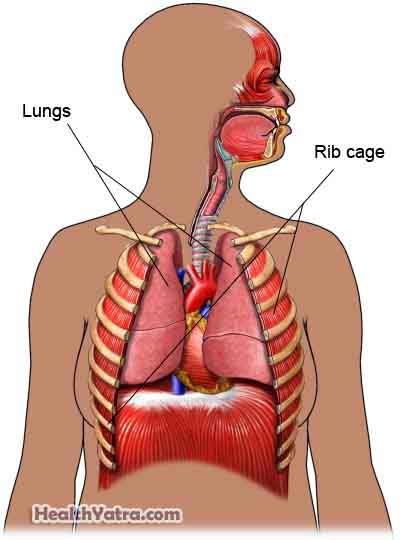Definition
A needle biopsy of the lung or pleura is done to remove a sample of lung or pleural tissue or fluid. Pleura is the lining of the lungs and chest wall. Once the tissue is removed, it will be examined in a lab.

Reasons for Procedure
This procedure is used to diagnose abnormal tissue in or around the lung. Possible reasons for abnormal tissue are:
- Noncancerous tumors
- Cancer
- Lung tissue scarring
- Pneumonia
- Other infections (eg, tuberculosis or histoplasmosis)
- Abnormal blood vessels in the lung
- As a consequence of certain systemic diseases (eg, rheumatoid arthritis,sarcoidosis, or Wegener’s granulomatosis)
Possible Complications
Complications are rare, but no procedure is completely free of risk. If you are planning to have a needle biopsy, your doctor will review a list of possible complications, which may include:
- Collapsed lung
- Bleeding
- Infection
- Damage to the liver or spleen
Factors that may increase the risk of complications include:
- Smoking
Make sure to tell your doctor if you are pregnant.
What to Expect
Prior to Procedure
Your doctor may order:
- A complete physical exam
- X-ray —a test that uses radiation to take a picture of structures inside the body
- CT scan —a type of x-ray that uses a computer to make pictures of the inside of the body
- Ultrasound—uses sound waves to make pictures of the inside of the body
- Blood tests
Leading up to your procedure, do not start taking any new medicines without consulting your doctor.
You may be given pre-procedure medicines for certain conditions (eg, to suppress a cough).
Talk to your doctor about your medicines. You may be asked to stop taking some medicines up to one week before the procedure, like:
- Aspirin or other anti-inflammatory drugs
- Blood thinners, such as clopidogrel (Plavix) or warfarin (Coumadin)
Anesthesia
- You may receive a mild sedative about an hour before the procedure. It will help you relax.
- You may also have an injection of a local anesthetic. It will numb the area where the needle will be inserted.
Description of the Procedure
Your skin will be cleaned with an antiseptic solution. You will be in a seated position, leaning forward, with your arms resting on a table for support. You should remain as still as possible. An ultrasound or CT scan will be used to locate the exact area.
A small cut will be made in your skin. Then, while you hold your breath, the biopsy needle will be inserted through the cut. The needle will be passed between your ribs until it reaches the lung or pleura. Your doctor then withdraws some cells through the biopsy needle. The needle will be withdrawn. Pressure will be put on the site of the incision. When the bleeding stops, a bandage will be applied.
How Long Will It Take?
Between 30-60 minutes
How Much Will It Hurt?
- Before the procedure, when the local anesthetic is injected, you may feel a brief sting.
- During the procedure, when the needle is inserted, you will probably feel some pressure. If you are having a lung biopsy, you will feel a quick, sharp pain when the needle touches your lung.
Post-procedure Care
At the Care Center
- You may rest for several hours after the procedure. A nurse will check on you and monitor your recovery.
- A few hours after the procedure, a chest x-ray or other imaging technique may be done. This is done to make sure a lung has not collapsed and that there is no bleeding.
- If there are no complications after four hours, you may go home.
At Home
When you return home, do the following to help ensure a smooth recovery:
- Rest at home for a day or two.
- Avoid strenuous activities for one week.
- You may remove the bandage after a day or two.
- Ask your doctor about when it is safe to shower, bathe, or soak in water.
- Be sure to follow your doctor’s instructions.
Ask your doctor when to expect the results of the biopsy.
Call Your Doctor
After arriving home, contact your doctor if any of the following occurs:
- Signs of infection, including fever and chills
- Redness, swelling, increasing pain, excessive bleeding, or any discharge from the incision site
- Pain that you cannot control with the medicines you have been given
- Cough, shortness of breath, or chest pain
- Coughing up blood
- Pain when taking a deep breath
- You feel your heart rate is fast
In case of an emergency, call for medical help right away.
